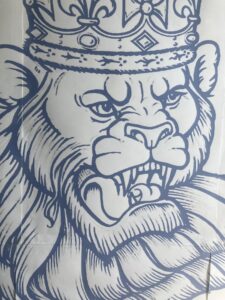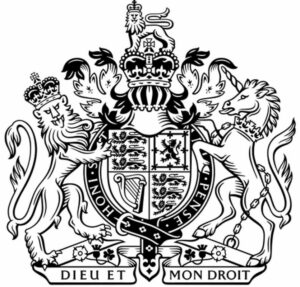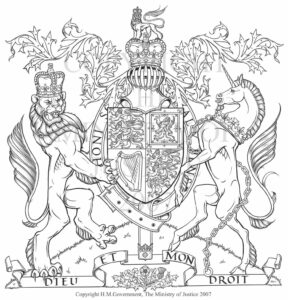THE ROYAL ARMS UPDATED
 Kevin Arkinstall, FSHA
Kevin Arkinstall, FSHA
Originally appeared in The Armiger’s News, Volume XLVIII, Number 3, Summer 2025
Many moons ago I was approached by the Ministry of Justice to redraw the Royal Arms. The image which they were using at the time was very small and as this was just prior to the easy use of vector graphics, it was felt necessary to have a completely new drawing made.
The brief was to make a drawing which would be reproduced at any size between half a metre, up to one and a half metres high. My drawing was made using a sable brush and black gouache, then photographed at very resolution and stored on a computer disc. It was a huge file which took so much memory in the PC at the time that each edit took around fifteen minutes to process.
Frustratingly, technology moved on at a rapid pace, and only a short time later I could have used vectors to create the drawing and eliminated a great deal of the hassle involved.
The image was well received, however after signing over all the rights, I remain in the dark as to whether it was put to official use.
A curious side note to the story relates to the original drawing, which I believe was produced in the 1940s or 50s.
My contact in the Government informed me that in addition to being too small and the resolution too poor for the kind of enlargement required, the original artwork had long since disappeared.
 At left is a photo of part of the lion supporter’s head at about the smallest size it was meant to be reproduced at. If you look closely, you can see that the image is printed on several sheets of paper which are pieces together. The edges are just visible, and the sheets are each A3 in size. The Ministry asked that the arms should be capable of reproduction at A4, which they just about are, with a corresponding loss of line weight. However, on a small screen they really lose most of their impact.
At left is a photo of part of the lion supporter’s head at about the smallest size it was meant to be reproduced at. If you look closely, you can see that the image is printed on several sheets of paper which are pieces together. The edges are just visible, and the sheets are each A3 in size. The Ministry asked that the arms should be capable of reproduction at A4, which they just about are, with a corresponding loss of line weight. However, on a small screen they really lose most of their impact.
The other drawing though was very small, and I believe it really only meant for letter headings. The penciled instructions certainly indicated a reduction of 30-50% from recollection. Part of the dissatisfaction from the government department was purely down to years of misuse, where the small drawing had been enlarged far beyond what is reasonable; something which the original draughtsman would not have approved of.
Years of other artists copying, tracing, and playing “graphic Chinese whispers” have also taken their toll. Until recently an awful lot of official governmental heraldry was carried out by graphic design departments with little or no specialisation in heraldic art.
Having fairly recently relocated to rural Devon, I was thus greatly surprised about a year after delivering my drawing, to be introduced to a local man who had a scrap book of heraldic ephemera. Mostly snipped off headed paper bearing the Royal Arms. It struck me as slightly odd that the letters themselves had been discarded, and for the most part the Royal Arms were embossed duplicates, albeit in different coloured inks – except one page, which was a black and white original drawing of the Royal Arms, marked up with pencil instructions for the exact dimensions and percentage for reproduction. Specifically, reduction, as that used to be the only way to ensure crisp line work for reproductive purposes. The drawing was at most ten centimetres across, so would have been useless for the current requirements; but still an amazing coincidence to find so far from its origins, in a scrapbook in a sleepy Devon town where I had recently set up my studio!

